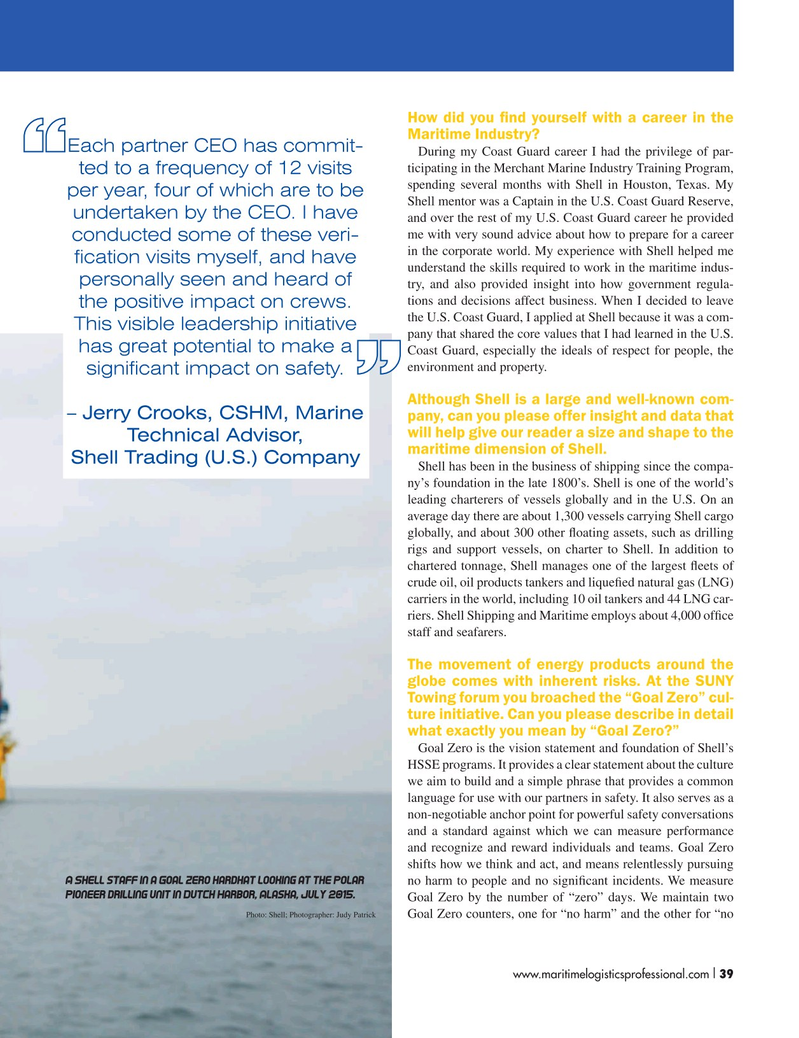
Page 39: of Maritime Logistics Professional Magazine (Q3 2016)
Shipbuilding, Repair & Maintenance
Read this page in Pdf, Flash or Html5 edition of Q3 2016 Maritime Logistics Professional Magazine
How did you ? nd yourself with a career in the
Maritime Industry?
Each partner CEO has commit-
During my Coast Guard career I had the privilege of par- ticipating in the Merchant Marine Industry Training Program, ted to a frequency of 12 visits spending several months with Shell in Houston, Texas. My per year, four of which are to be
Shell mentor was a Captain in the U.S. Coast Guard Reserve, undertaken by the CEO. I have and over the rest of my U.S. Coast Guard career he provided me with very sound advice about how to prepare for a career conducted some of these veri- in the corporate world. My experience with Shell helped me ? cation visits myself, and have understand the skills required to work in the maritime indus- personally seen and heard of try, and also provided insight into how government regula- tions and decisions affect business. When I decided to leave the positive impact on crews. the U.S. Coast Guard, I applied at Shell because it was a com-
This visible leadership initiative pany that shared the core values that I had learned in the U.S. has great potential to make a
Coast Guard, especially the ideals of respect for people, the environment and property. signi? cant impact on safety.
Although Shell is a large and well-known com- – Jerry Crooks, CSHM, Marine pany, can you please offer insight and data that will help give our reader a size and shape to the
Technical Advisor, maritime dimension of Shell.
Shell Trading (U.S.) Company
Shell has been in the business of shipping since the compa- ny’s foundation in the late 1800’s. Shell is one of the world’s leading charterers of vessels globally and in the U.S. On an average day there are about 1,300 vessels carrying Shell cargo globally, and about 300 other ? oating assets, such as drilling rigs and support vessels, on charter to Shell. In addition to chartered tonnage, Shell manages one of the largest ? eets of crude oil, oil products tankers and lique? ed natural gas (LNG) carriers in the world, including 10 oil tankers and 44 LNG car- riers. Shell Shipping and Maritime employs about 4,000 of? ce staff and seafarers.
The movement of energy products around the globe comes with inherent risks. At the SUNY
Towing forum you broached the “Goal Zero” cul- ture initiative. Can you please describe in detail what exactly you mean by “Goal Zero?”
Goal Zero is the vision statement and foundation of Shell’s
HSSE programs. It provides a clear statement about the culture we aim to build and a simple phrase that provides a common language for use with our partners in safety. It also serves as a non-negotiable anchor point for powerful safety conversations and a standard against which we can measure performance and recognize and reward individuals and teams. Goal Zero shifts how we think and act, and means relentlessly pursuing
A Shell staff in a Goal Zero hardhat looking at the Polar no harm to people and no signi? cant incidents. We measure
Pioneer drilling unit in Dutch Harbor, Alaska, July 2015.
Goal Zero by the number of “zero” days. We maintain two
Photo: Shell; Photographer: Judy Patrick
Goal Zero counters, one for “no harm” and the other for “no www.maritimelogisticsprofessional.com 39I 34-49 Q3 MP2016.indd 39 8/17/2016 10:32:22 AM

 38
38

 40
40
